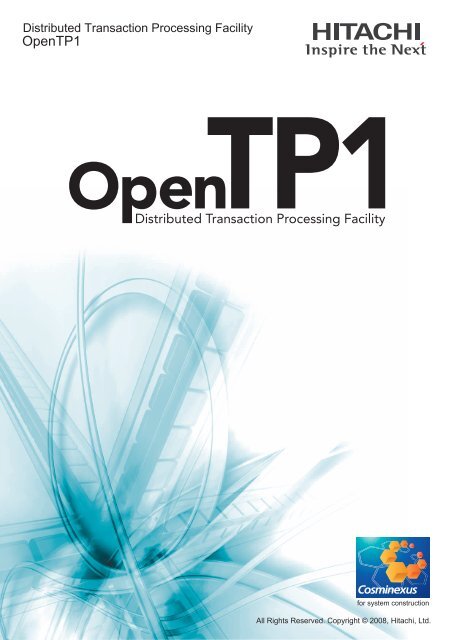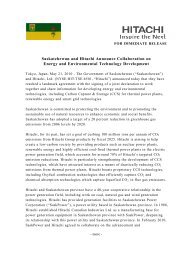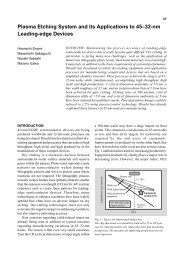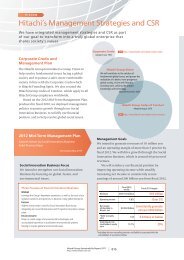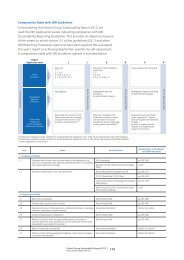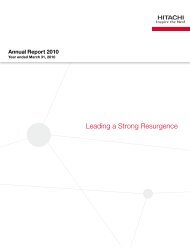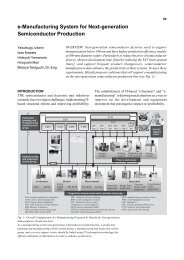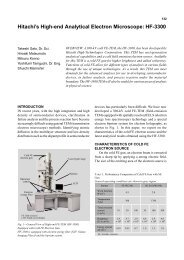Distributed Transaction Processing Facility OpenTP1 [PDF ... - Hitachi
Distributed Transaction Processing Facility OpenTP1 [PDF ... - Hitachi
Distributed Transaction Processing Facility OpenTP1 [PDF ... - Hitachi
Create successful ePaper yourself
Turn your PDF publications into a flip-book with our unique Google optimized e-Paper software.
<strong>Distributed</strong> <strong>Transaction</strong> <strong>Processing</strong> <strong>Facility</strong><br />
<strong>OpenTP1</strong><br />
for system construction<br />
All Rights Reserved. Copyright © 2008, <strong>Hitachi</strong>, Ltd.
Highly reliable, high-performance<br />
online transaction processing for<br />
next-generation core business<br />
Business operations and institutional services could not function today without computer systems. Keeping the<br />
mission-critical systems of such operations in non-stop working order is our greatest challenge. <strong>OpenTP1</strong>, the<br />
distributed transaction manager, realizes field-proven highly reliable OLTP. <strong>OpenTP1</strong> powerfully supports<br />
mission-critical systems. Systems can be built in various configurations, without compromising the exceptional<br />
performance and reliability crucial for a mission-critical system. <strong>OpenTP1</strong> enables the provision of services in the<br />
configurations that meet the needs of each user. <strong>OpenTP1</strong> also provides flexible solutions to the issue of creating<br />
a new system while also making use of existing resources. With its proven reliability and success, <strong>OpenTP1</strong><br />
assures that your business operations will keep running smoothly.<br />
<strong>OpenTP1</strong> client<br />
client<br />
<strong>OpenTP1</strong> server<br />
Multi-node clustered system<br />
Server<br />
Mission-critical system<br />
Mainframe<br />
Internet<br />
Web server<br />
Application server<br />
Server<br />
WS/PC<br />
Web browser<br />
Client<br />
PC<br />
PC<br />
Mobile phone<br />
PDA<br />
1
Stable operation of mission-critical systems<br />
in every type of situation<br />
<strong>OpenTP1</strong> provides the core functionality of an OLTP system by applying tried and tested mainframe<br />
technologies. High reliability is maintained by the recovery function and the journal acquisition, etc..<br />
Scheduling control enables steady quick response even if processing requests increase. The system's<br />
operating status can be monitored and analyzed to detect signs of slower response, and operations<br />
can be automated to lessen administrative workloads.<br />
Support of new technologies for continually<br />
evolving system environments<br />
A variety of system configurations are possible to suit the particular needs of each customer.<br />
The <strong>OpenTP1</strong> system supports Service Oriented Architecture (SOA). The applications used in<br />
<strong>OpenTP1</strong> can be made available as services, and available services can be accessed from<br />
<strong>OpenTP1</strong> applications.<br />
Flexible inter-system linkage for effectively<br />
applying and integrating legacy systems<br />
Systems differ according to the environment in which they are used. <strong>OpenTP1</strong> lets you build a<br />
mission-critical system in a variety of configurations. The wealth of protocols and application interfaces<br />
make it possible to link systems and apply legacy systems effectively. Migration from a mainframe<br />
system can also be accomplished easily.<br />
2
Mission-Critical<br />
A highly reliable, highly available, high-performance system is realized for<br />
further improving business continuity.<br />
<strong>Transaction</strong> control<br />
<strong>OpenTP1</strong> provides transaction control based on two-phase<br />
commitment to assure data integrity in a distributed computing<br />
environment. This enables data updating across multiple<br />
resources and global transaction control across multiple<br />
servers.<br />
■ Two-phase commitment synchronization<br />
AP Update request DB DB<br />
Journal<br />
<strong>OpenTP1</strong> OK DBMS1 DBMS2<br />
Instruction for preparation<br />
Instruction for preparation<br />
Completion of preparation<br />
OK<br />
OK<br />
Instruction for commitment<br />
Instruction for commitment<br />
Completion of processing<br />
OK<br />
1st phase 2st phase<br />
Scheduling facility<br />
<strong>OpenTP1</strong> controls the processes and the schedule to efficiently<br />
handle the service requests to applications. <strong>OpenTP1</strong> manages<br />
the processes of the applications running on <strong>OpenTP1</strong> Server<br />
and limits the number of processes to be generated, enabling<br />
efficient application of resources. <strong>OpenTP1</strong> also provides a load<br />
balancing scheduling facility and a dynamic process generation<br />
facility that efficiently apply the limited number of processes,<br />
enabling precise application scheduling.<br />
Such features let you build a high-performance system capable<br />
of handling high traffic volumes.<br />
■ Scheduling facility<br />
<strong>OpenTP1</strong><br />
client<br />
CALL<br />
<strong>OpenTP1</strong><br />
(scheduler)<br />
Queue 1<br />
Queue 2<br />
Queue 3<br />
Process 1 (resident)<br />
Server AP 1<br />
FIFO<br />
Process 2 (resident)<br />
Server AP 2<br />
Load-balance Process 3 (resident)<br />
Server AP 2<br />
Process 4 (non-resident)<br />
Generates Server AP 3<br />
a non-resident process<br />
Recovery services<br />
Full or partial recovery can be automatically performed after a<br />
system failure. When the <strong>OpenTP1</strong> system is linked with a<br />
database management system (DBMS) through the XA interface<br />
of the DTP model defined by The Open Group (formerly X/Open),<br />
recovery instructions are sent to the DBMS when the application<br />
is recovered. <strong>OpenTP1</strong> collects checkpoint dumps, trace<br />
information, and log information, and manages the <strong>OpenTP1</strong> end<br />
status and the status of the files necessary to restart <strong>OpenTP1</strong>.<br />
This can abridge the recovery time when any error occurs.<br />
Journal acquisition<br />
■ Partial application recovery<br />
Error!<br />
AP1<br />
AP2<br />
<strong>OpenTP1</strong> server<br />
1. Detection<br />
2. Re-scheduling<br />
3. Auto-recovery<br />
AP3<br />
AP1<br />
Services provided regardless<br />
of the AP1 status<br />
Historical information for system recovery, statistical<br />
information for system tuning, and other application logs can<br />
be collected in the form of journals, in case of a contingent<br />
failure.<br />
■ Type of journals<br />
Type<br />
Synchronization-point journal<br />
Recovery journal<br />
Statistical journal<br />
User journal<br />
Description<br />
Gets information on settled transactions.<br />
Gets update information of resources.<br />
Gets statistical information for system tuning.<br />
Gets user-specified information collected<br />
according to AP instructions.<br />
Category<br />
History<br />
information<br />
Statistical information<br />
User information<br />
Database linkage<br />
<strong>OpenTP1</strong> conforms to the DTP model of The Open Group<br />
(formerly, X/Open) and supports the XA and TX interfaces.<br />
DBMS linkage ensures data integrity.<br />
■ Compliance with the DTP model provided by X/Open<br />
Resource<br />
manager<br />
AP<br />
SQL TX XATMI<br />
XA<br />
<strong>Transaction</strong><br />
manager<br />
XA +<br />
<strong>OpenTP1</strong><br />
Communication<br />
resource manager<br />
■ DBMSs available<br />
for XA collaboration<br />
HiRDB<br />
XDM/RD<br />
DB2<br />
Microsoft ® SQL Server<br />
Oracle<br />
Sybase<br />
3
Mission-Critical<br />
File system<br />
<strong>OpenTP1</strong> provides two types of file systems to store the user data used by <strong>OpenTP1</strong> application processes; DAM files* 1 used<br />
as dedicated <strong>OpenTP1</strong> direct access files, and TAM files* 2 that can be used as dedicated <strong>OpenTP1</strong> direct access files while<br />
enabling high speed access by the table access method. Since they are resource managers managed by <strong>OpenTP1</strong>, <strong>OpenTP1</strong><br />
manages their transactions.<br />
*1: Provided by uCosminexus TP1/FS/Direct Access<br />
Node switching<br />
*2: Provided by uCosminexus TP1/FS/Table Access<br />
The <strong>OpenTP1</strong> system environment can be placed on standby on<br />
a secondary node as backup for the active node. This enables<br />
the system to be quickly switched over to the standby node<br />
when a failure occurs on the active node, so that services can<br />
continue without interruption. When the active node needs to be<br />
shut down for maintenance, for example, you can terminate the<br />
active node and switch to the standby node simply by entering a<br />
planned switching command on the active node.<br />
■ System switching at failure<br />
Production<br />
node<br />
HA product<br />
<strong>OpenTP1</strong><br />
Failure<br />
LAN<br />
Auto-switching<br />
Shared disk<br />
Auto-switching<br />
Application server linkage<br />
HA product<br />
<strong>OpenTP1</strong><br />
Standby<br />
node<br />
■ Linkage with HA Monitor<br />
HA Monitor performs status monitoring on a regular basis to<br />
detect whether a slowdown or loop of <strong>OpenTP1</strong> has occurred.<br />
<strong>OpenTP1</strong> also provides functionality for reporting errors to HA<br />
Monitor, thus enabling early error detection. Deployment of a hot<br />
standby system in which <strong>OpenTP1</strong> processes are kept running<br />
on the standby node further reduces the time required for<br />
failover.<br />
■ HA products for collaboration<br />
AIX ®<br />
HP-UX<br />
Solaris<br />
Linux<br />
Windows ®<br />
HA Monitor<br />
HACMP<br />
HA Monitor<br />
HA Toolkit Extension<br />
MC/ServiceGuard<br />
HA Toolkit Extension<br />
SafeCLUSTER<br />
VERITAS Cluster Server<br />
HA Monitor<br />
HA Toolkit Extension<br />
Microsoft ® Cluster Server (MSCS)<br />
HA: High Availability<br />
<strong>OpenTP1</strong> can be linked to each type of application server using uCosminexus TP1/Client/J. Linkage with uCosminexus Application<br />
Server enables application development based on J2EE Connector Architecture (J2CA), transaction linkage, and connection pooling,<br />
etc. By using uCosminexus TP1/Message Queue - Access, you can perform transaction linkage compliant with Java Message<br />
Service (JMS), thereby ensuring data consistency between the message queue in <strong>OpenTP1</strong> and the database on the application<br />
server.<br />
■ Linkage with Web Application Server<br />
WS/PC<br />
XML/<br />
SOAP<br />
J2EE Application Server<br />
<strong>Transaction</strong> server<br />
PC<br />
Mobile phone<br />
PDA<br />
HTML<br />
WML/<br />
CHTML<br />
HTTP<br />
Web<br />
server<br />
Web<br />
Application<br />
server<br />
<strong>OpenTP1</strong><br />
client<br />
<strong>OpenTP1</strong><br />
Server AP<br />
<strong>Hitachi</strong> or IBM<br />
mainframe<br />
■ Supported application servers<br />
uCosminexus Aplication Server<br />
WebSphere<br />
WebLogic<br />
Information<br />
appliance<br />
*<strong>Transaction</strong> linkage is supported only with<br />
uCosminexus Application Server.<br />
4
Operation<br />
Operation support is provided to simplify the usage of complex systems and<br />
reduce the burden on our customers.<br />
Management using Job Management Partner (JP1)<br />
Using the linkage with the JP1 integrated operations management software, <strong>OpenTP1</strong> provides stable system operation and<br />
vastly reduces administrative workloads. As for the operation, JP1 automates a whole range of daily tasks, from powering on/off<br />
the server used for <strong>OpenTP1</strong>-based online processing to starting and stopping the system. As for system monitoring, the<br />
integrated console provided by JP1 enables the operator to grasp failure information for the various types of events that occur in<br />
<strong>OpenTP1</strong> at a glance: in which applications a failure occurred, which applications are affected by the failure, etc.. By monitoring<br />
performance information, failures can be prevented in advance. As for error handling, users can be alerted automatically by<br />
email, patrol lamp, or mobile phone notification when a problem occurs. If performance deteriorates, users can modify or expand<br />
the system by adding servers.<br />
■ Examples of JP1 operations management<br />
Automation of daily online operations<br />
Visual monitoring window<br />
8:00<br />
Server power on<br />
Operation<br />
JP1<br />
Monitoring<br />
System startup<br />
Error<br />
handling<br />
Reporting<br />
Automatic execution<br />
of linked applications<br />
Backup<br />
Scenario-based<br />
scale out and<br />
scale in<br />
Integrated console<br />
System shutdown<br />
Server power off<br />
<strong>OpenTP1</strong><br />
server<br />
Various events occur<br />
Operating<br />
information<br />
Event notification<br />
24:00<br />
<strong>OpenTP1</strong> system<br />
<strong>OpenTP1</strong> report window<br />
Diagnostics window<br />
Trace facility for performance verification<br />
Trace information is collected for major<br />
events generated during <strong>OpenTP1</strong><br />
operation. This information enables<br />
thorough examination of the system's<br />
operating status, and can be usefully<br />
applied in performance tuning, stable<br />
routine operation, and problem<br />
diagnostics. Since the same process<br />
IDs are used in the trace information<br />
of both uCosminexus Application<br />
Server and <strong>OpenTP1</strong>, events can be<br />
traced to their source.<br />
■ Trace facility for performance verification<br />
uCosminexus Application Server<br />
<strong>OpenTP1</strong> client<br />
Client AP<br />
Request Process start<br />
Service request<br />
Response received<br />
Process end<br />
Service request received<br />
Scheduler<br />
Response reply<br />
<strong>OpenTP1</strong><br />
Server AP<br />
Application<br />
processing<br />
User processing start<br />
User processing end<br />
Statistical information<br />
Various statistical information is<br />
collected to assist in system tuning<br />
and error diagnostics. Real-time<br />
collection of statistical information,<br />
system performance monitoring, and<br />
predictive monitoring of deterioration<br />
in performance can all help to increase<br />
reliability.<br />
■ Collection of statistical information<br />
Clients<br />
<strong>OpenTP1</strong><br />
AP<br />
Export of statistical data<br />
Statistical<br />
information file<br />
Types of statistical information<br />
System statistics<br />
<strong>Transaction</strong> statistics<br />
Response statistics<br />
Communication delay statistics<br />
Administrator<br />
5
System Configuration<br />
A variety of system configurations are supported to flexibly satisfy business<br />
requirements.<br />
Web-based systems<br />
As well as creating a new Web-based system,<br />
you can bring an existing <strong>OpenTP1</strong> system to<br />
the Web. The method of making the Web-based<br />
system can be chosen to suit your system<br />
environment.<br />
■ Access through J2EE TM (J2CA collaboration)<br />
Server<br />
■ Configuration with an application server<br />
You can build a Web-based system by linking<br />
to an application server product. Especially,<br />
uCosminexus Application Server is an<br />
excellent choice because the connection<br />
pooling facility provided by the application<br />
server and the transactions initiated on the<br />
application server can be handled by<br />
<strong>OpenTP1</strong> as they are.<br />
■ Configuration with .NET Framework<br />
You can build an OLTP system that uses<br />
<strong>OpenTP1</strong> in a .NET Framework environment.<br />
Also, with ASP.NET, you can convert an<br />
existing system or an <strong>OpenTP1</strong> system not<br />
based on .NET Framework to a Web<br />
environment.<br />
■ Configuration with the <strong>OpenTP1</strong> Internet<br />
Gateway<br />
uCosminexus TP1/Web converts requests<br />
from a Web browser to the <strong>OpenTP1</strong> interface.<br />
This enables users to access an <strong>OpenTP1</strong><br />
system from a Web browser. Also, by<br />
deploying XMAP3/Web, a MAP system can be<br />
converted to a Web site.<br />
Web browser<br />
Web browser<br />
■ Access through .NET Framework<br />
Web browser<br />
Web browser<br />
■ Access through <strong>OpenTP1</strong> Internet gateway<br />
Web browser<br />
Web browser<br />
Internet/Intranet Internet/Intranet Internet/Intranet<br />
Web<br />
server<br />
Web<br />
server<br />
(IIS)<br />
Web<br />
server<br />
(IIS)<br />
AP<br />
uCosminexus<br />
Application<br />
Server<br />
AP<br />
.NET Framework<br />
AP<br />
<strong>OpenTP1</strong><br />
client<br />
<strong>OpenTP1</strong><br />
client<br />
uCosminexus TP1/Web<br />
DB<br />
<strong>OpenTP1</strong><br />
client<br />
DB<br />
DB<br />
RPC<br />
RPC<br />
RPC<br />
AP<br />
<strong>OpenTP1</strong><br />
DB<br />
Server<br />
AP<br />
<strong>OpenTP1</strong><br />
DB<br />
Server<br />
AP<br />
<strong>OpenTP1</strong><br />
DB<br />
DB<br />
DB<br />
IIS: Internet Information Services<br />
6
System Configuration<br />
Client-server systems<br />
A client-server system consists of client terminals and a<br />
server. <strong>Processing</strong> requests are sent from the clients via a<br />
GUI created with an application such as Visual Basic, and the<br />
processing results are returned from the server to the clients.<br />
■ Client-server systems<br />
Client<br />
<strong>OpenTP1</strong> Client<br />
Client AP<br />
Server<br />
<strong>OpenTP1</strong><br />
Server AP<br />
RPC<br />
Mainframe-linked systems and legacy system migration<br />
<strong>OpenTP1</strong> supports many different protocols. <strong>OpenTP1</strong> has been widely applied in mainframe-linked systems and in migration<br />
from mainframe systems. A MAP system on a mainframe can be migrated to an open system by linking to XMAP3. In a<br />
non-mainframe environment, an <strong>OpenTP1</strong> system can communicate with other non-<strong>OpenTP1</strong> systems using supported<br />
protocols. <strong>OpenTP1</strong> has high affinity with <strong>Hitachi</strong>'s XDM/DCCM3 transaction processor, and remote procedure calls (RPCs) can<br />
be used in addition to TCP/IP for communication between <strong>OpenTP1</strong> and XDM/DCCM3.<br />
■ Mainframe-linked systems<br />
XMAP3<br />
XMAP3<br />
<strong>OpenTP1</strong><br />
TCP/IP<br />
Non-<strong>OpenTP1</strong><br />
system<br />
AP<br />
TCP/IP<br />
DCCM3<br />
Web browser<br />
Web server<br />
DB<br />
RPC<br />
Message queuing systems<br />
<strong>OpenTP1</strong> supports asynchronous communication that accumulates messages and transmits the messages to the remote system<br />
when required, so users need not be concerned about the status of the remote system. Functionality is provided to prevent sent<br />
messages from being dropped or duplicated. An <strong>OpenTP1</strong> system can be linked with a WebSphere MQ system because the<br />
systems are compatible with each other at the API and TCP/IP level. When uCosminexus TP1/Message Queue - Access is<br />
deployed, since messages are registered to and retrieved from uCosminexus TP1/Message Queue, a non-<strong>OpenTP1</strong> system can<br />
also register/retrieve messages to/from the message queue.<br />
■ Message queuing systems<br />
<strong>OpenTP1</strong> system<br />
Remote system<br />
Web browser<br />
<strong>OpenTP1</strong><br />
MQ system<br />
Web browser<br />
Internet/Intranet<br />
Web<br />
server<br />
uCosminexus<br />
Application<br />
Server<br />
<strong>OpenTP1</strong><br />
Client<br />
RPC<br />
TP1/MQ<br />
Queue<br />
file<br />
Queue<br />
file<br />
MQ<br />
Queue<br />
file<br />
Queue<br />
file<br />
Synchronized updating<br />
DB<br />
Messages guaranteed<br />
7
System Connection<br />
Three communication modes are available to suit the features of your<br />
system.<br />
Remote procedure calls<br />
Communication between <strong>OpenTP1</strong><br />
application programs is realized by using<br />
remote procedure calls (RPCs) over a<br />
network connected by TCP/IP protocol.<br />
The application programs need not be<br />
aware of the protocol procedure, the<br />
remote system's IP address, and the<br />
communication port. <strong>OpenTP1</strong> supports<br />
synchronous, asynchronous, and<br />
non-responsive RPCs.<br />
Client<br />
<strong>OpenTP1</strong> Client<br />
Client AP<br />
RPC<br />
Message transmission<br />
Messages are sent and received in<br />
accordance with procedures specified by<br />
communication protocols. <strong>OpenTP1</strong><br />
provides libraries for the various<br />
protocols available, and an API for<br />
sending and receiving messages.<br />
Messages can be transmitted using the<br />
required protocol's communication<br />
procedure not only between <strong>OpenTP1</strong><br />
systems but also from non-<strong>OpenTP1</strong><br />
systems.<br />
Message queuing<br />
Server Remote system <strong>OpenTP1</strong> system <strong>OpenTP1</strong> system<br />
<strong>OpenTP1</strong><br />
<strong>OpenTP1</strong><br />
<strong>OpenTP1</strong><br />
Remote<br />
Server AP<br />
system's AP<br />
Message control<br />
Server AP<br />
AP TP1/MQ<br />
Message reception<br />
Put message<br />
Queue<br />
Remote WAN<br />
file<br />
system's AP<br />
Message transmission<br />
AP<br />
Get message Queue<br />
file<br />
Applications can communicate with each<br />
other using the <strong>OpenTP1</strong> message<br />
queuing functionality. Since the<br />
communication process is controlled by<br />
<strong>OpenTP1</strong> until the messages queued in<br />
<strong>OpenTP1</strong> are accumulated in the remote<br />
system's queue, no messages are<br />
dropped or duplicated. Because<br />
asynchronous communication is used,<br />
users need not be aware of the status of<br />
the communication system.<br />
MQ system<br />
Queue<br />
manager<br />
Queue<br />
file<br />
Queue<br />
file<br />
AP<br />
Get message<br />
AP<br />
Put message<br />
Migration to SOA platforms is supported to ensure business flexibility.<br />
SOA support<br />
<strong>OpenTP1</strong> applications are structured as individual<br />
services, which means that existing resources can<br />
be applied effectively and there is potential for the<br />
future system migration to an SOA platform.<br />
Applications created in COBOL can be made<br />
openly available as services.<br />
? ■ Existing <strong>OpenTP1</strong> services provided by SOA linkage<br />
<strong>OpenTP1</strong><br />
<strong>OpenTP1</strong><br />
Existing AP developed with <strong>OpenTP1</strong><br />
AP developed with <strong>OpenTP1</strong> for<br />
.NET Framework<br />
RPC<br />
RPC SOAP<br />
Enterprise service bus (ESB)<br />
uCosminexus Service Platform<br />
■ uCosminexus Service Platform<br />
Existing and newly created <strong>OpenTP1</strong> applications<br />
can be deployed as services using the enterprise<br />
service bus (ESB) provided by uCosminexus<br />
Service Platform. This enables existing resources to<br />
be applied effectively across the various systems,<br />
and increases the types of services that can be<br />
offered in the whole system.<br />
■ <strong>OpenTP1</strong> for .NET Framework<br />
.NET Framework enables users to create <strong>OpenTP1</strong><br />
applications and facilitates Web service<br />
development using ASP.NET. Because standard<br />
interfaces such as SOAP can be used, user<br />
applications can be created as Web services.<br />
■ uCosminexus TP1 Gateway<br />
uCosminexus TP1 Gateway enables SOA services<br />
on an enterprise service bus to be accessed by<br />
existing <strong>OpenTP1</strong> client and server systems.<br />
SOAP<br />
Web server<br />
■ Access to the services from an existing <strong>OpenTP1</strong> system using SOA linkage<br />
SOAP<br />
Internet/Intranet<br />
Web services<br />
SOAP client<br />
SOAP<br />
Enterprise service bus (ESB) uCosminexus Service Platform<br />
uCosminexus TP1 Gateway<br />
RPC<br />
MQ<br />
Existing terminal<br />
<strong>OpenTP1</strong><br />
Visual Basic window<br />
Existing system<br />
8
Development<br />
Support is provided for quick and easy development of business<br />
applications.<br />
Application server linkage<br />
TP1/COBOL adapter for Cosminexus Version 2 can be used with <strong>OpenTP1</strong>. This tool automatically generates JavaBeans<br />
(Beans for TP1/COBOL access) for enabling communication from a Java application to a COBOL application running on<br />
<strong>OpenTP1</strong>.<br />
■ Application server linkage development support facility<br />
Web browser<br />
Internet/Intranet<br />
HTTP<br />
SOAP<br />
Web<br />
server<br />
AP<br />
uCosminexus<br />
Application<br />
Server<br />
Beans for<br />
TP1/COBOL<br />
Access<br />
<strong>OpenTP1</strong><br />
client<br />
Send/Receive<br />
RPC<br />
<strong>OpenTP1</strong> server<br />
Server AP<br />
(COBOL)<br />
Web service client<br />
Development<br />
environment<br />
Beans for<br />
TP1/COBOL<br />
Access<br />
Generate<br />
automatically<br />
Server AP<br />
(COBOL)<br />
TP1/COBOL adapter for Cisminexus<br />
.NET Framework support<br />
<strong>OpenTP1</strong> application programs can be developed not only in C, C++, and COBOL but also in VB.NET, C#, J#, and the .NET<br />
version of COBOL (COBOL2002 for .NET Framework). <strong>OpenTP1</strong> for .NET Framework provides tools for generating source<br />
code templates and for debugging created applications, using the development support facility built into Visual Studio.<br />
Developers can easily create Web front-end applications and Web services with ASP.NET.<br />
■ .NET Framework linkage development support facility<br />
Web browser<br />
Web browser<br />
HTTP<br />
Internet/Intranet<br />
Web<br />
server<br />
(IIS)<br />
ASP.NET<br />
.NET Framework<br />
<strong>OpenTP1</strong><br />
client<br />
RPC<br />
<strong>OpenTP1</strong><br />
Server AP<br />
Web browser<br />
SOAP<br />
■ XML Web services wizard ■ SPP.NET wizard ■ SPP.NET debugger<br />
When the user enters information according to the wizard, an<br />
application template will be automatically generated.<br />
The debugger enables you to debug server applications without<br />
creating any test program (client).<br />
■ Development languages<br />
Server<br />
Client<br />
C, C++, COBOL2002, C#, J#, and Visual Basic .NET<br />
C, C++, COBOL2002, C#, J#, Visual Basic .NET , Visual Basic, and Java<br />
9
■ Product List<br />
Basic server product<br />
Additional server<br />
products<br />
Basic network products<br />
Additional network<br />
products<br />
Internet-related product<br />
Message-queue-related<br />
products<br />
Client products<br />
Application server<br />
collaboration products<br />
.NET Framework<br />
collaboration products<br />
uCosminexus TP1/Server Base Basic<br />
Basic control for distributed transaction-processing environments<br />
uCosminexus TP1/LiNK<br />
Basic control for distributed application system environments<br />
uCosminexus TP1/FS/Direct Access<br />
High reliability/performance file service<br />
uCosminexus TP1/FS/Table Access<br />
Recoverable memory table<br />
uCosminexus TP1/Online Tester<br />
The online tester that has <strong>OpenTP1</strong> run in the test mode<br />
uCosminexus TP1/Offline Tester<br />
The offline tester that verifies <strong>OpenTP1</strong> APIs<br />
uCosminexus TP1/High Availability<br />
High reliability facility for distributed transaction processing<br />
uCosminexus TP1/Multi<br />
<strong>OpenTP1</strong> Multi-node operation facility<br />
uCosminexus TP1/Resource Manager Monitor<br />
External resource manager control facility<br />
uCosminexus TP1/Shared Table Access<br />
Inter-node shared table facility<br />
uCosminexus TP1/Extension1<br />
Extended facility 1 for <strong>OpenTP1</strong> large-scale systems<br />
uCosminexus TP1/Terminal Control Library for Finance Financial terminal control support facility<br />
Extended <strong>OpenTP1</strong> facilities including high reliability facilities and multithreading facilities that use<br />
uCosminexus TP1/Server Base Enterprise Option<br />
technology acquired by development of mainframe data communication programs<br />
uCosminexus TP1/Message Control<br />
Network control for communication protocol management<br />
uCosminexus TP1/NET/Library<br />
Common library for network control<br />
uCosminexus TP1/Messaging<br />
Message control facility on Windows ®<br />
uCosminexus TP1/NET/High Availability<br />
High reliability facility for network control<br />
uCosminexus TP1/Message Control/Tester<br />
Online tester for network control<br />
uCosminexus TP1/NET/OSI-TP<br />
Message exchange support facility based on the OSI-TP protocol<br />
uCosminexus TP1/NET/TCP/IP<br />
Message exchange support facility based on the TCP/IP protocol<br />
uCosminexus TP1/NET/User Datagram Protocol<br />
Message exchange support facility based on the UDP/IP protocol<br />
uCosminexus TP1/NET/XMAP3<br />
Message exchange support facility based on the XP protocol<br />
uCosminexus TP1/NET/X25<br />
Message exchange support facility based on the X.25 procedure<br />
uCosminexus TP1/NET/HDLC<br />
Message exchange support facility based on the HDLC procedure<br />
uCosminexus TP1/NET/User Agent<br />
Message exchange support facility based on the OSAS UA protocol<br />
uCosminexus TP1/NET/OSAS-NIF<br />
Message exchange support facility based on the OSAS NIF protocol<br />
uCosminexus TP1/NET/HSC<br />
Message exchange support facility based on the HSC1/2 procedure<br />
uCosminexus TP1/NET/Secondary Logical Unit-TypeP2 Message exchange support facility based on the SLU TypeP protocol secondary-station<br />
uCosminexus TP1/NET/NCSB<br />
Message exchange support facility based on the NCSB protocol<br />
uCosminexus TP1/Web<br />
The gateways accessing from Web browsers to <strong>OpenTP1</strong> systems through RPC or Send<br />
uCosminexus TP1/Message Queue<br />
Message queuing facility<br />
uCosminexus TP1/Message Queue - Access<br />
<strong>Transaction</strong> collaboration facility with TP1/Message Queue<br />
Message Queue - Operation - Center<br />
The monitoring console that is used to monitor message queuing systems in collaboration with JP1/Cm2<br />
Message Queue - Operation - Agent<br />
The target node whose message queuing system is monitored in collaboration with JP1/Cm2<br />
uCosminexus TP1/Client/P<br />
Libraries running on PCs as <strong>OpenTP1</strong> clients<br />
uCosminexus TP1/Client/W<br />
Libraries running on WSs as <strong>OpenTP1</strong> clients<br />
uCosminexus TP1/Client/J<br />
Class libraries for accessing from Java TM servlets, Java TM applets, and Java TM applications to <strong>OpenTP1</strong> systems<br />
uCosminexus TP1/Client for .NET Framework<br />
<strong>Facility</strong> for accessing from .NET Framework to <strong>OpenTP1</strong><br />
uCosminexus TP1 Connector<br />
The facility for accessing from Java TM applications to <strong>OpenTP1</strong> systems through JCA interfaces<br />
uCosminexus TP1 Gateway<br />
Gateway facilities for using SOA services from an <strong>OpenTP1</strong> system<br />
The facility that automatically generates JavaBeans TM (TP1/COBOL access beans) for communication<br />
TP1/COBOL adapter for Cosminexus Version 2<br />
between Java TM applications and <strong>OpenTP1</strong> COBOL applications<br />
TP1/COBOL Extended Server Run Time System for Cosminexus Version 2 Libraries for executing auto-generated TP1/COBOL access beans on PCs<br />
TP1/COBOL Extended Run Time System for Cosminexus Version 2 Libraries for executing auto-generated TP1/COBOL access beans on UNIX machines<br />
uCosminexus TP1/Extension for .NET Framework .NET Framework-compliant extension product<br />
uCosminexus TP1/Connector for .NET Framework<br />
The facility that enables access from ASP .NET to <strong>OpenTP1</strong><br />
ASP: Active Server Pages *Note that supported facilities vary depending on your platform.<br />
10
■ Supported platforms<br />
AIX 5L<br />
<strong>OpenTP1</strong> client products <strong>OpenTP1</strong> server products<br />
Windows Vista ®<br />
HP-UX*<br />
Solaris<br />
Red Hat Enterprise Linux*<br />
Windows ® 2000<br />
Windows ® XP<br />
Windows Server 2003*<br />
* The Itanium ® Processor Family (IPF) is also supported.<br />
AIX is a registered trademark of the International Business Machines Corp. in the U.S.<br />
DB2 is a registered trademark of the International Business Machines Corp. in the U.S.<br />
HP-UX is a product name of Hewlett-Packard Company.<br />
Itanium is a registered trademark of Intel Corporation or its subsidiaries in the United States and other countries.<br />
Java and all Java-based trademarks and logos are trademarks or registered trademarks of Sun Microsystems, Inc. in the United States and other countries.<br />
Linux is a registered trademark of Linus Torvalds.<br />
Microsoft is a registered trademark of Microsoft Corp. in the U.S. and other countries.<br />
Microsoft SQL Server is a product name of Microsoft Corp.<br />
Visual Basic is a registered trademark of Microsoft Corp. in the U.S. and other countries.<br />
Windows is a registered trademark of Microsoft Corp. in the U.S. and other countries.<br />
Windows Server is a registered trademark of Microsoft Corporation in the United States and/or other countries.<br />
Windows Vista is a registered trademark of Microsoft Corporation in the United States and/or other countries.<br />
ORACLE is a registered trademark of Oracle Corporation.<br />
Red Hat is a trademark or a registered trademark of Red Hat Inc. in the United States and other countries.<br />
UNIX is a registered trademark of The Open Group in the United States and other countries.<br />
VERITAS is a trademark or registered trademark of Symantec Corporation in the U.S. and other countries.<br />
WebLogic is a registered trademark of BEA Systems, Inc.<br />
X/Open is a registered trademark of X/Open Company Limited in the U.K. and other countries.<br />
Other product and company names mentioned in this document may be the trademarks or registered trademarks of their respective owners.<br />
<strong>OpenTP1</strong> has been developed<br />
under a quality assurance system<br />
approved by ISO9001 and TickIT.<br />
Information service<br />
The service provides information about <strong>OpenTP1</strong> over the internet. http://www.hitachi.co.jp/soft-e/<br />
<strong>Hitachi</strong>, Ltd.<br />
<strong>Hitachi</strong>, Ltd., Software Division<br />
5030 Totsuka-cho,Totsuka-ku,Yokohama-shi, Kanagawa-ken, 244-8555 Japan<br />
E-mail: WWW-mdc@itg.hitachi.co.jp<br />
Feb., 2008


